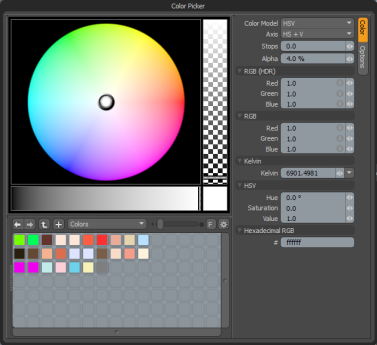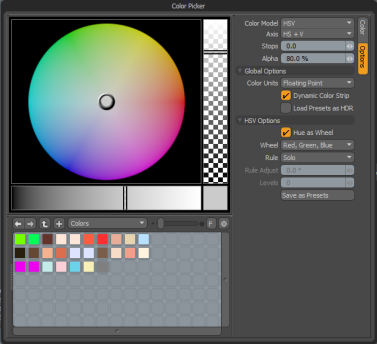Search is based on keyword.
Ex: "Procedures"
Do not search with natural language
Ex: "How do I write a new procedure?"
Color Picker Viewport
Color is an integral function when painting and surfacing for 3D. Color sets the mood, leads a viewer's eye, and provides a sense of cohesion to a scene. Modo provides a dedicated window for editing colors and creating schemes for scenes, which can then be easily applied when surfacing, setting up lights, and any other color-related operation. The Color Picker opens whenever you click on a color swatch in Modo. Being non-modal, the pop-up disappears as soon as you move your mouse cursor away from it.
The viewport is dominated by the Color Picker with its color wheel on the left and the color options on the right, joined by a Preset Browser across the bottom. Combined with its many options, the color wheel is a full-featured color scheme generator, with options for creating a variety of automatically-coordinated schemes based on various rules that you can adjust.
The wheel itself is straight-forward. You only need to click the color you wish to choose, or click and drag to update the value in real-time. Releasing the mouse pointer when you've chosen a color, it's selected and the values in the panel to the right are filled in. Depending on the color model, the color strip below the wheel updates accordingly. You can click and drag in that strip to change it as well.
The right side of the Color Picker offers you the ability to define alpha (transparency) values, with the box in the lower-right corner displaying the current color swatch. Right-click the color swatch to save the color as a preset. Automatic preset saving can also be accomplished by dragging and dropping the swatch into the preset window.
For aspects of Modo that require two colors, such as when working with procedural textures, you can simultaneously define both colors by clicking the arrow to swap foreground/background colors. Once you define the colors you can click the arrows to swap back and forth. The Properties panel on the far-right side controls the display of the picker and allows you to define numerical values, as well as to set the scheme rules and save presets to the browser below.
Some of the options in the Color tab include:
• Color Model - this option allows you to choose the color model that suits your needs best. There are three current options:
• HSV- standing for Hue, Saturation, and Value, it's considered the most intuitive color model. You can adjust colors by their Hue, the apparent color itself, Saturation, the intensity of the color, and Value, how light or dark the color is.
• Kelvin - the Kelvin scale is based on thermal dynamics, and considers colors as temperatures. This single axis scale is useful in describing the color of light sources, as the hotter they burn, the brighter, and more white they become. The scale ranges from warm colors - reds and oranges - through yellow to white, extending to a slight blue as it increases to the maximum value.
• RGB - standing for Red, Green, and Blue, the model itself is based on the additive property of light. If pure versions of each color are combined, they produce white light. While it is a common model, it's not very intuitive, as you might not have a good idea about what happens if you want to reduce Red by 50%. Still, it is the most common format for colors when exchanging data between applications.
• Axis - since the Color Picker is two dimensional and the various color spaces are multi-dimensional, the additional axis options modify how you interact with the picker, providing additional options for customizing the picker and color strip to suit your needs.
• Stops - this option is related to f-stops (familiar to photographers). It's intended to aid in previewing and selecting HDR (High Dynamic Range) colors, whose brightness goes beyond what typical computer monitors are capable of displaying. At the default 1.0 value, the Color Picker works like any other, maxing out at pure white. Changing the stops value to 1.4 allows you to define colors whose brightness is twice that of the 1.0 setting. A stop of 2.0 would again be twice as bright (or four times brighter than 1.0).
These values work the same as those in photography, where each additional stop value lets in twice as much light as the previous. The standard photographic progression of stops is 1, 1.4, 2, 2.8, 4, 5.8, 8, 11, 16, and 22. It should be noted that the Stops value only changes how Modo displays the colors in the picker, allowing you the ability to choose over-bright values in the color wheel. It doesn't change the color value itself. Additionally, the stops value affects those colors selected using the OS-specific color pickers.
• Alpha - Use this to adjust color amounts on standard materials, for example, diffuse or specular color. You can also modify color amounts with this while painting.
Additionally, there are further options available under Models.
Models
The five following sections, RGB(HDR), RGB, Kelvin, HSV and Hexadecimal RGB, are simply numeric value input fields for displaying and entering colors, using alternate color models. Displayed values always represent the current foreground color and update accordingly as you interact with the picker. All models, except RGB (HDR), are not capable of defining or displaying HDR colors, and clip at the maximum values for the selected model (showing whatever the equivalent color is). The maximum value is different for each of the various Color Units options, as defined by you.
Global Options
When you click on the Options tab, a few new options are added to the panel.
• Color Units - changes the global preference for how color values are entered into the Modo color fields. There are four options for this control:
• Floating Point - for this model, standard color values exist between 0 and 1, with HDR color values being those beyond 1.0.
• Percentage - color values are defined as percentages, similar to Floating Point values, where up to 100% are normal color range, and values beyond 100% extend into the HDR colors.
• Integer - this is the standard format for most image editing applications, where standard color values exist in the 0 to 255 range.
• Hexadecimal - the standard for defining color on the web, as they are natural values for computers to understand. This is similar to binary, where the two values represent 255 different levels.
• Dynamic Color Strip - when this option is checked, the color strip updates dynamically, showing the color selection as a component of the bar itself. When unchecked, the bar simply shows its single color axis, as defined by the Axis option.
• Load Presets as HDR - when a value is saved, it's tagged as either a LDR (Low Dynamic Range) color or HDR (High Dynamic Range) color. Enabling the Load Presets as HDR allows you to only load HDR color presets from the browser, effectively hiding all the LDR colors from view (they are still there, only hidden). This is an easy way to determine if colors are HDR or LDR in a given scheme.
HSV Options
• Hue as Wheel - when the Color Model Options of HSV is selected, enabling the Hue as Wheel option displays the picker as a continuous wheel. When displayed as such, several options related to making rule-based color schemes becomes available.
• Wheel - this option defines the type of HSV wheel to display. You can choose the standard Red, Green, Blue (RGB) option common to many image editing applications, or the more familiar and artist-friendly Red, Yellow, Blue version. Unlike the RGB version, the RYB version works like the color wheel many artists learn in art school, where red and green, blue and orange, and yellow and purple oppose each other on the wheel.
• Rule - Modo allows multiple options for generating automatic schemes, based on common color rules:
• Solo - the default mode, only a single color is defined.
• Complementary - two colors whose positions oppose each other on the color wheel.
• Analogous - three colors that contain a similar hue, appearing close to each other on the color wheel.
• Triadic - a three-color scheme, where colors appear equidistant from each other on the color wheel.
• Tetradic - a four-color scheme, where colors appear equidistant from each other on the color wheel (dual complementary).
• Compound - a five-color scheme, with a main color and two split complementary colors.
• Tints - appear as graduated value (brightness) variations of the foreground color towards white.
• Shades - appear as graduated value (brightness) variations of the foreground color towards black.
• Rule Adjust - adjust the angle of degrees between scheme rules that modifies the scheme to suit your own taste.
• Levels - this option becomes active for the Tints and Shades rules, defining how many steps are in the scheme.
• Save as Presets - pressing this button saves the current foreground color into the Presets > Colors folder of the preset content. If the default content hasn't been installed, you need to manually define a directory and add it to the preset browser using the Add Path... option. When defining color schemes using the rule options, all the color defined in the swatch patch is added to the preset browser simultaneously.
Tip: You can access your system-level (OS) color picker at any time by clicking on the color swatch in the lower-right corner of the Color Picker itself. You should note that any colors selected in this way are also affected by the Stops value.
Sorry you didn't find this helpful
Why wasn't this helpful? (check all that apply)
Thanks for your feedback.
If you can't find what you're looking for or you have a workflow question, please try Foundry Support.
If you have any thoughts on how we can improve our learning content, please email the Documentation team using the button below.
Thanks for taking time to give us feedback.

